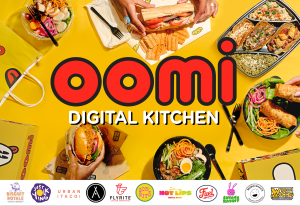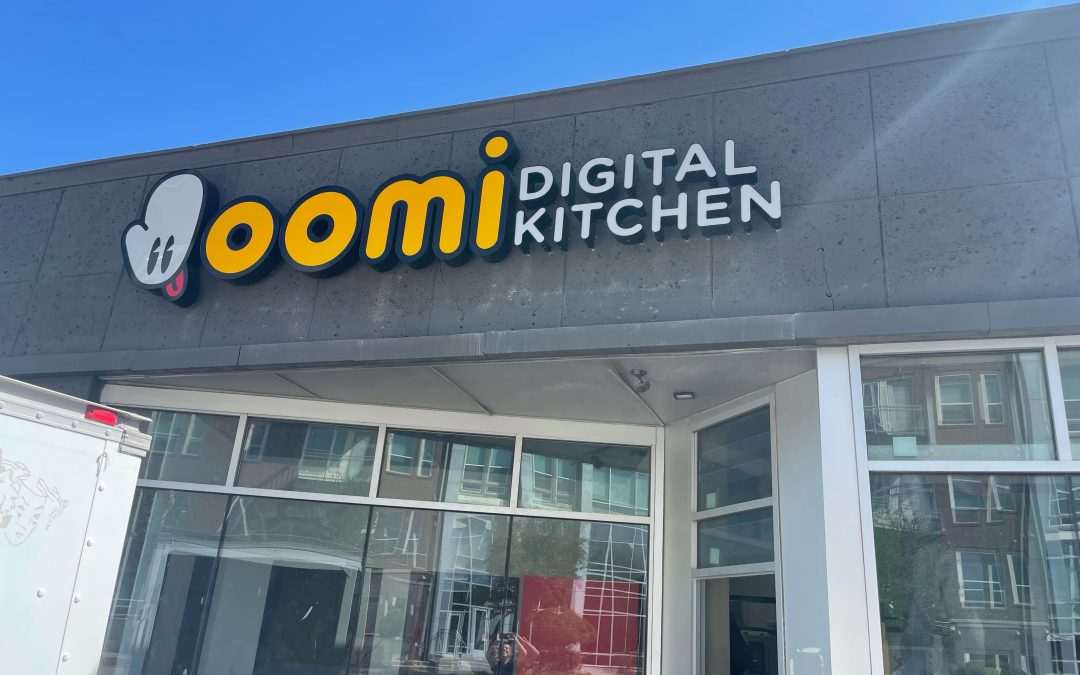Surrounded by apartments on the edge of downtown Dallas, OOMI Digital Kitchen is building what it calls an evolved ghost kitchen model first popularized by CloudKitchens and Kitchen United. With outside brands and in-house virtual concepts cooked by its own staff in one centralized space, OOMI believes it has found a way for restaurants to generate more profitable orders and quicker deliveries.
The company’s first location is the product of two brick-and-mortar restaurant operators who feel that more traditional, multi-brand ghost kitchens are alienating independent restaurant operators in favor of chain restaurants and charging too much for everyone involved.
At just 2,000 square feet—most of that dedicated to a centralized cooking space—OOMI’s storefront is marked with colorful signage welcoming customers to order online or pick up orders in person.

Markus Pineyro
Referencing aspects he likes from other second-wave ghost kitchens, co-founder Markus Pineyro said All Day Kitchens, Hungry House, Ghost Truck Kitchen and Clustertruck all have elements he and his business partner, Roger Herrera, gleaned while building the OOMI template.
Those “second wave” features include facilities built closer to end users, one collective team cooking a mix of outside and in-house brands, avoiding freeze-and-heat meals, self-ordering kiosks and smart pickup lockers, and skipping a dine-in component so its facilities are nimble enough to fit into places larger ghost kitchens cannot.
“We said let’s make this much more nimble, let’s reduce the risk [for operators] and take control of the entire vertical,” Pineyro said of OOMI’s pre-construction research. “We want to license your brand, you don’t need to allocate resources, we’re going to staff it and sell your product out of one central kitchen. We don’t have stalls, it’s just one large kitchen.”
In-house vs. outside brands
Ahead of a grand opening slated for early November, OOMI signed national sandwich franchise Which Wich, Austin-based Flyrite Chicken and Urban Taco, Pineyro’s existing brick-and-mortar brand that’s already a top performer on third-party platforms in the Dallas market.
 Anticipating a 60/40 split between outside and in-house brands, the remainder of its capacity will be soaked up by additional virtual brands that OOMI developed with the help of an outside analytics firm that analyzed approximately 80 data points—including Yelp reviews and local ordering data—to create a handful of delivery-only brands that would appeal to the existing client base with common delivery fare including coffee, salads, sandwiches and chicken wings.
Anticipating a 60/40 split between outside and in-house brands, the remainder of its capacity will be soaked up by additional virtual brands that OOMI developed with the help of an outside analytics firm that analyzed approximately 80 data points—including Yelp reviews and local ordering data—to create a handful of delivery-only brands that would appeal to the existing client base with common delivery fare including coffee, salads, sandwiches and chicken wings.
Staying lean and nimble includes the small size of the facility itself. Skipping a dine-in component means that its first ghost kitchen is municipally required to have just 22 parking spaces, which allows OOMI to “slide into” locations that are more urban and closer to consumers, be they at-home diners or office workers.
The company has placed a significant focus on each customer group by placing self-pickup kiosks in nearby apartments and office buildings, and working with workplace delivery brands like Foodsby and Lunchdrop. Interested parties can request OOMI pods be added to their apartment or business through the company’s website.
“With us, they can come in and offer to the same building 10 different restaurants at the same time,” he added of workplace users. “They expand their menu, they expand their offering, and we’re leveraging their built-in business…and don’t have to rely on our own demand and our own marketing, we can go in and leverage the marketplaces.”
That marketplace-friendly approach includes national delivery providers like Uber Eats and DoorDash. Pineyro said his team doesn’t subscribe to the idea that third-parties are bad for a ghost kitchen’s business, and said thinking about their exposure as a marketing expense makes all of the difference.
“It falls right in line,” he said of delivery commissions compared with more traditional marketing at his brick-and-mortar locations. “Over three months we 5X’d our sales and were able to drop our commissions by half, so then if you do a small market on your prices, we were netting out 5 percent commission for the extra revenue.”
Like most ghost kitchen providers, OOMI will have its own native ordering solution and will work to convert third-party customers to its less expensive first-party channel. That includes a loyalty program that gives customers free delivery for the first month.
Reducing the cost of delivery
Bringing down the costs of delivered meals for customers has been a significant goal from the earliest days of OOMI. Comparing other facilities where delivery fees for a single person can exceed $15 is something he called “unbelievable” and something that it feels will depress ordering volumes.
“We’re able to deliver for just $2, so it’s about a 75 percent savings on the delivery fee, which is very significant over time, especially for a demographic that is ordering 4-5 times a week—it really adds up,” he said of large-batch orders.
While many of OOMI’s foundational pillars are common across the ghost kitchen industry, Pineyro said he’s learned from David Chang’s highly publicized Fuku brand launch in Texas, which reportedly had issues with a lack of drivers and slow cooking times.
 The company has also found lessons in virtual providers they feel have struggled with food quality, and also concepts like Hungry House that attract a different set of culinary “makers.” That also includes Clustertruck, which only cooks its own brands inside of its ghost kitchen facilities.
The company has also found lessons in virtual providers they feel have struggled with food quality, and also concepts like Hungry House that attract a different set of culinary “makers.” That also includes Clustertruck, which only cooks its own brands inside of its ghost kitchen facilities.
“When you’re so hidden as an independent operator and you’re completely reliant on a third-party, you just dug yourself a hole that is going to be very hard to come out of,” he said. “You have no visibility, no brand awareness and you’re relying solely on an algorithm that’s not working in your favor.”
In seeking to find an edge over what it calls “food tech bros” in the industry, its founder doubled down on the importance of restaurant people developing the concepts, courting outside brands and cooking the food themselves.
Still owning brick-and-mortar restaurants has helped OOMI recruit its opening round of chefs and culinary professionals.
“There’s been a lot of people who don’t have a background in the restaurant industry who are trying to run restaurants, trying to figure out the food,” Pineyro said. “We’re leveraging the innovation that has happened over the last two years to our favor, but we’re still running a restaurant because that’s what we do.”


